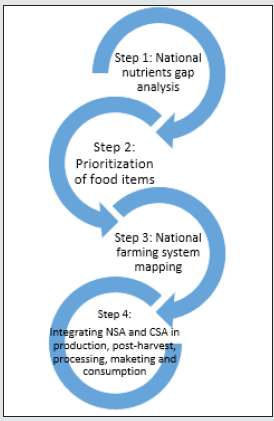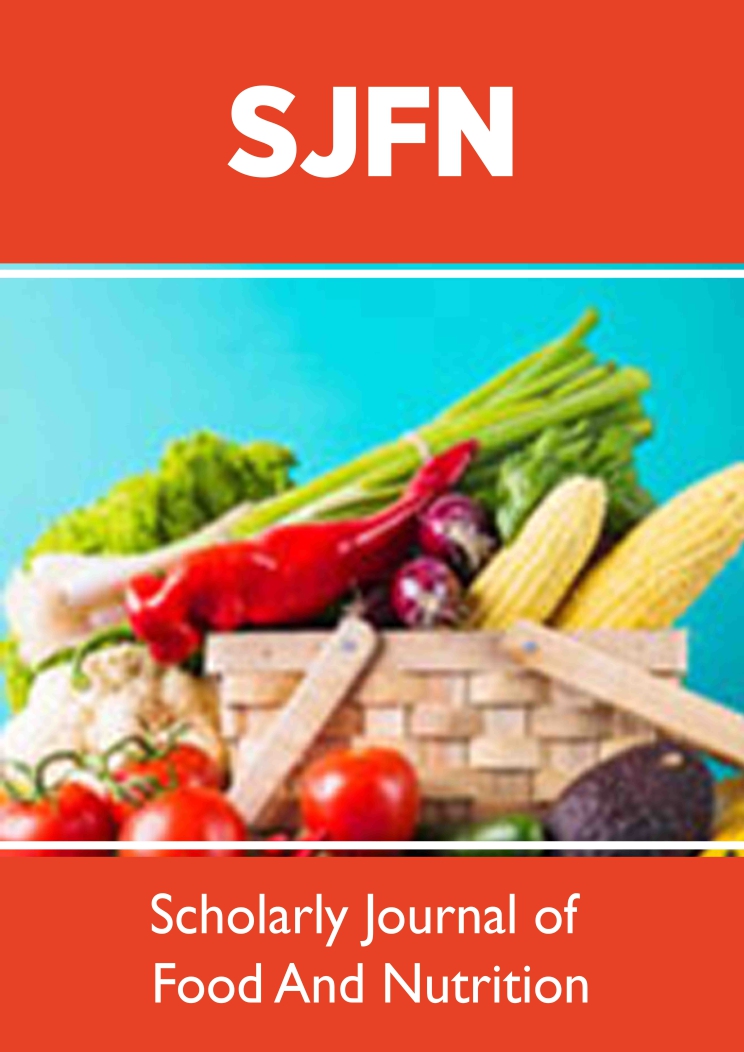
Lupine Publishers Group
Lupine Publishers
Menu
ISSN: 2638-6070
Opinion Article(ISSN: 2638-6070) 
Strategic Transformation of Agriculture Food Systems: Direction and Approach
Volume 4 - Issue 1Xuan Li1* and Kadambot H M Siddique2
- 1Senior Policy Officer, Ph.D, Regional Office for Asia and the Pacific, Food and Agriculture Organization of the United Nations (FAO), Thailand.
- 2Hackett Professor of Agriculture Chair and Director, The UWA Institute of Agriculture, The University of Western Australia; UN FAO Special Ambassador for the International Year of Pulses 2016
Received:June 26, 2021; Published:August 3, 2021
*Corresponding author:The views expressed in this publication are those of the author(s) and do not necessarily reflect the views or policies of the Food and Agriculture Organization of the United Nations./p>
DOI: 10.32474/SJFN.2021.04.000180
Introduction
Despite significant improvements in food security and nutrition, many countries in the Asia-Pacific region face significant challenges related to hunger and malnutrition. The most pressing policy priority is to ensure food and nutrition security for all. Food security and nutrition has become more serious due to the COVID-19 pandemic. Agriculture is the main source of food security, nutrition, and people’s livelihoods in the Asia-Pacific region. However, production and dietary diversity are limited in many countries due to the over-reliance on limited staples [1]. Strategic agriculture and food system transformation is required to achieve the Second Sustainable Development Goal (SDG2) (Zero Hunger) by 2030.
Gaps
Ongoing debates on agriculture food systems (agri-food systems) transformation prevail worldwide in terms of how it should be reoriented to address SDG2. Two research gaps are apparent. Firstly, few studies have examined the direction how agricultural production should be reoriented to meet population’ nutritional needs at national level in a resource-constrained world. A starting point is to assess what nutrition gaps exist in a specific country to meet the nutritional requirements of its population. However, there are limited evidence-based analyses assessing the magnitude of nutrition and production gaps at the national level.
Secondly, in terms of approaches, countries are offered different approaches on how agri-food systems should be transformed without integration. Nutrition-sensitive agriculture (NSA) and climate-resilient agriculture (CSA) are two of them that have different objectives with distinct interventions, achieving nutritional security (NSA) and adapting to climate change while increasing agricultural productivity and reducing greenhouse gas emissions (CSA). NSA is a food-based approach to agricultural development that promotes nutritionally rich foods, dietary diversity, and food fortification to combat malnutrition and micronutrient deficiencies [2]. In contrast, CSA develops actions to transform and reorient agri-food systems to ensure food security under climate change [3]. While both approaches have their own merits, different actors are promoting each approach at global, regional, and national levels. A disconnect prevails between both streams in terms of research, development, and application, dividing agri-food systems development.
Implications
The above research gaps have strong implications for agri-food systems development. Firstly, the lack of nutritional analysis provides no guidance on the direction of agri-food systems transformation for achieving the nutritional targets of SDG2. The national nutrition assessment sets the foundation on what and where do we produce sufficient, nutritious and healthy foods to close the nutrition gap in the climate change context. Without this baseline assessment, the agricultural production systems can hardly be optimized against the resources availability. Secondly, the disconnect between the NSA and CSA approaches may lead to a scenario where policymakers and local producers must choose approach A or B in the given agricultural fields, without realizing that A and B can and should be integrated. Thus, if NSA and CSA remain disconnected in terms of the concepts, approaches, and interventions for agricultural transformation, the production and nutrition gaps will not be closed, let alone the Zero Hunger Goal.
Methodology
The food system transformation should address Zero Hunger/SDG2. Strategic transformation of agri-food systems should set the direction to close nutrition gap at macro- and micro-level. Optimal planning should be based on a series of evidence-based analysis, especially nutrients analysis, priority food items analysis, and food system mapping analysis to integrate priority food items. Government plays a leading role in the direction and approach of national agri-food systems transformation. From a policy perspective, a four-step approach is proposed as follows: [Figure 1]
The first step identifies the deficits or surplus of nutrients, including energy, major macro- and micro-nutrients (e.g. calcium, potassium, sodium, vitamin A, vitamin B and C, folate, iron, magnesium, phosphorus, zinc, thiamin, riboflavin, niacin, etc) at a national level by assessing the current nutrient demand and supply through i) nutrients demand analysis, ii) nutrients supply analysis, and iii) nutrient gap analysis. In terms of nutrient supply analysis, it should calculate domestic production of the food items and convert them into nutrient supply based on food composition table (per unit of the food item). In terms of nutrient demand analysis, it should calculate population and nutrient requirement by age and sex group data based on national dietary guideline. These evidencebased analyses will estimate the gaps of nutrients at the country level and set the grounds for what to produce at macro-level to close the nutrition gap.
The second step identifies what to produce at micro-level in agri-food systems to close the nutrition gap. This is a key step to restructure the food production systems based on scientific analysis. To prioritize the food items, a multidisciplinary approach to select appropriate crops and species based on their nutrients, agriculture, and ecological traits, addressing specific nutrition gaps, needs to be conducted [4]. To this end, given the existence of over 30,000 edible plant species, the FAO developed a strategy to harness neglected and underutilized species (NUS) for agriculture diversification [1, 5]. A four-dimensional selection methodology was developed to identify NUS as Future Smart Food based on four parameters: a) nutritional density; b) climate-resilience; c) economic viability; d) locally availability or adaptability [1,6,7,8].
Numerous Asian countries have used this methodology to prioritize NUS at the national level with the technical assistance of FAO. The methodology can also be applied at sub-national and local levels to select and boost local agri-food systems. However, it requires research collaboration between different disciplines, including nutrition, agriculture (seeds, soil, water, etc.), and ecology, in particular, food composition data for indigenous crop species that are limited due to inadequate research.
The third step is to map where to produce these food items once prioritized to integrate them into farming systems that can optimize the utility of limited resources. Optimal mapping analysis of these priority crops in diversified agro-ecological zones should be conducted by using geospatial information systems (GIS) and ground measurements [9]. Such geospatial analyses integrating parameters of specific crops, agro-ecological zoning, climate, water, soil, seasons, and markets offer evidence-based projections on where to produce specific crops for decision-making. This is a critical step for policy-maker to reorient the agricultural production structure to close the nutrition gap at the national level based on scientific findings.
Once the optimal fields for priority crops are identified, the next step is to identify an integrated approach how to produce these food items effectively in the specific agricultural fields. An integrated NSA and CSA approach should be applied throughout the production, post-harvest, processing, marketing, and consumption stages. How to produce, harvest, store, process, pack, label, distribute, trade, and prepare these foods requires an interdisciplinary approach.
Systematic interventions at key entry points integrating nutritionsensitive and climate-smart interventions into agri-food systems should be identified [10, 11]. Creating an enabling environment promoting production, processing, post-harvest management, marketing and consumption of selected food items with integrated nutrition-sensitive and climate-smart approach is important [12].
Conclusion
The current agri-food systems must be diversified and reoriented to address two intertwined challenges of Zero Hunger and climate change adaptation. Government plays a central role in setting the direction and approach of national agri-food systems transformation. A four-step approach is proposed to strategize the transformation: firstly, a national nutrition gap analysis should be undertaken to set the grounds for what to produce at macro-level. Secondly, a country should employ a multidisciplinary analysis to identify what to produce at micro-level to close the nutrition gap. The third step is for a country to map where to product these food items to optimize the utility of limited resources by using GIS tools. Lastly, based on projections of the optimal fields for priority crops, a country should identify integrated approach how to produce these food items effectively by integrating NSA and CSA in the process of the agri-food systems transformation.
Acknowledgments
We thank the partners of FAO’s Future Smart Food initiative for their collective efforts and intellectual contributions to the development of FSF. In particular, we thank Dr. Mohmand Solh for his guidance and stimulation on the subject.
References
- FAO (2018) Future Smart Food: rediscovering hidden treasures of neglected and underutilized species for Zero Hunger in Asia. X Li, KHM Siddique, eds. Bangkok.
- FAO (2014) Nutrition-Sensitive Agriculture, Second International Conference on Nutrition: Better Nutrition, Better Lives (ICN2).
- FAO, Climate Smart Agriculture Sourcebook.
- FAO (1995) Dimensions of Need: An Atlas of Food and Agriculture. Rome, FAO.
- Fanzo J, Hunter D (2013) Agricultural biodiversity, diverse diets and improving nutrition. In, Diversifying Food and Diets: Using Agricultural Biodiversity to Improve Nutrition and Health. Agricultural Biodiversity. Earthscan, UK p. 1-13.
- Li X, Siddique KHM (2020) Future Smart Food: harnessing the potential of neglected and underutilized species for Zero Hunger. Matern Child Nutr 16: e13008.
- Li X, Yadav R, Siddique KHM (2020) Neglected and underutilized crop species: the key to improving dietary diversity and fighting hunger and malnutrition in Asia and the Pacific. Front Nutr 7: 593711.
- Siddique KHM, Li X, Gruber K (2021) Rediscovering Asia’s forgotten crops to fight chronic and hidden hunger. Nature Plants 7: 116-122.
- FAO (2017) Policy Brief on Future Smart Food: Agriculture Diversification and healthy diet.
- H Jaenicke, D Virchow (2013) Entry points into a nutrition-sensitive agriculture. Food Secur 5: 679-692.
- Adhikari P, Araya H, Aruna G, Balamatti A, Banerjee S, et al. (2018) System of crop intensification for more productive, resource-conserving, climate-resilient, and sustainable agriculture: Experience with diverse crops in varying agroecologies. International Journal of Agricultural Sustainability 16(1): 1-28.
- FAO (2019) Mountain agriculture: Opportunities for harnessing Zero Hunger in Asia. Bangkok.

Top Editors
-

Mark E Smith
Bio chemistry
University of Texas Medical Branch, USA -

Lawrence A Presley
Department of Criminal Justice
Liberty University, USA -

Thomas W Miller
Department of Psychiatry
University of Kentucky, USA -

Gjumrakch Aliev
Department of Medicine
Gally International Biomedical Research & Consulting LLC, USA -

Christopher Bryant
Department of Urbanisation and Agricultural
Montreal university, USA -

Robert William Frare
Oral & Maxillofacial Pathology
New York University, USA -

Rudolph Modesto Navari
Gastroenterology and Hepatology
University of Alabama, UK -

Andrew Hague
Department of Medicine
Universities of Bradford, UK -

George Gregory Buttigieg
Maltese College of Obstetrics and Gynaecology, Europe -

Chen-Hsiung Yeh
Oncology
Circulogene Theranostics, England -
.png)
Emilio Bucio-Carrillo
Radiation Chemistry
National University of Mexico, USA -
.jpg)
Casey J Grenier
Analytical Chemistry
Wentworth Institute of Technology, USA -
Hany Atalah
Minimally Invasive Surgery
Mercer University school of Medicine, USA -

Abu-Hussein Muhamad
Pediatric Dentistry
University of Athens , Greece

The annual scholar awards from Lupine Publishers honor a selected number Read More...





